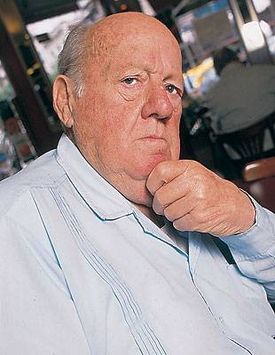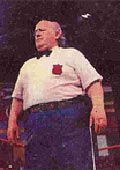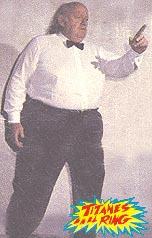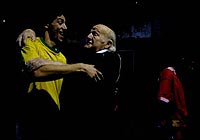William Boo
| William Boo | |||||||||||||||||||||||||||||
 |
|
||||||||||||||||||||||||||||
Obituary
(by Steve Sims)
Héctor Oscar Brea March 15th, 1927 – October 19th, 2006
Héctor Oscar Brea, who as “William Boo” (also called “William Amadeus Boo”) was by far the most famous referee in his home country in the history of professional wrestling, passed away on Thursday morning, October 19th, 2006, at the age of 79. Brea died at The Instituto Dupuytrén in the Balvanera neighborhood of Buenos Aires, Argentina, after a brief illness, though after a long bout with Type II (adult-onset) diabetes - Brea was extremely obese most of his adult life. This was Brea’s third trip to the hospital this year; the first was for fifteen days, and he apparently had just avoided having a foot amputated at that time. He had told the weekly magazine Semanario on August 16th of this year that his health was in total ruins, and how he was resigned to living the rest of his life having to use a wheelchair.
Who is the most famous referee ever in professional wrestling? To me, it can only be one man.
Let me ask you this. When the Seattle Seahawks were the “victims” of bad officiating in this past Super Bowl XL, did the announcers immediately tell the fans that the referee were making “Earl Hebner calls?” When Japan got jobbed this past March in the World Baseball Classic, did the announcers immediately holler how the umpires were making “Shiro Abe calls?” Yet there is a heel referee, almost 15 years after his last match (and nearly 20 after his last match on television), whose name is still referenced in his native country when bad calls arise in “legit” sports!

William Boo was born Héctor Oscar Brea March 15th, 1927, in a suburb of Buenos Aires, Argentina. Due to his large build (he was somewhat taller and much heavier than the average Argentinean man of the early 20th century, or the last 20th century for that matter, indeed, taller and larger than most of the wrestlers in the promotion), his foreign ring name, and his prematurely whitish-gray hair, Boo was often thought to be of European descent. Some people thought this because, after all, the primary co-founder of Titanes en el Ring, Martín Karadagián (also spelled sometimes as Caradagián), was of Armenian descent, some of his family fleeing the “ethnic cleansing” of the early 1900’s in what is now Turkey - something Karadagián fully and openly acknowledged this whenever asked. During quite a number of years of the first half of the 20th century, Buenos Aires and Argentina attracted quite a large (Eastern- and Western-) European-expatriate community, often fleeing religious persecution or a World War. Nonetheless, Brea himself claims to be from a long line of native Argentineans.
Boo’s story as a referee in inextricably intertwined with Karadigián’s Titanes promotion, thus I wish to set the scene in regards to the promotion as a whole, necessarily cutting a story that could (and has) fit a whole book down to 3-4 paragraphs just to set the background in which Boo worked.
Martín Karadagián, his wife, and his “co-founders” Joe Galera and Jorge Boccaci assumed control of a small wrestling promotion in 1954 that was headquartered at and from Buenos Aires’s La Luna Park Arena. By March 1962, the promotion had been renamed Titanes en el Ring and had gained a TV slot on Buenos Aires’s Channel 9. Among the wrestlers who first appeared on television in 1962 were Karadagián, La Momia, El Caballero Rojo, Yolanka the Space Creature, S.T.P., Il Comendatore, and El Mercenario Joe – wrestlers who would become household names to a generation of kids in Argentina. And right there with them from the very first television match was the big referee, William Amadeus Boo.
Titanes en el Ring became such a hit that the larger Channel 13 bought the rights to air the show in 1972, and held the weekly television tapings each weekend in a television studio-slash-arena where they squeezed in around 2000 fans every week. The Argentinean magazine Panorama defined Titanes en el Ring at its peak as “…the best program on television by its freshness, its vitality and its invention, that the most riotous surrealism occurs - at a primitive but authentic level -….”
Behind the fame, glamour, and spotlights, there were many people working very hard to ensure continued success week after week – and the big day was Monday, day of the booking meeting. Nobody was allowed to be absent for the decisive Monday meetings. “{The meeting) is more important that the matches,” said Karadagián. Everyone in attendance spoke up and expressed his opinion as to what had worked well and what had not in the prior week. Each match and character was dissected each and every week; e.g. what happened in this match or that match, what must be improved, how to get each character more over. All the meetings were characterized by a great discipline. Each character thus evolved; each one had its role and its program. Even though the typical carny secrecy was observed at the time, later, many of these details came out, much of it in a book self-published by Karadagián’s daughter Paulina.
One person with great responsibility in these meetings, as well as in the ring, was Héctor Oscar Brea, aka William Boo. In his beginnings (circa 1954) he was a boxer and then a luchador, where he first met Karadagián. The two quickly formed what ended up being a lifelong friendship. Boo was even the one put in charge of the promotion’s gymnasium (eventually he either owned this gym, or had at least a financial interest in it) where every night he supervised the maintenance and/or dismantling of the ring, and he was one of the lead trainers of the younger wrestlers during the week. Brea was the one who recommended the La Luna Park Arena to Karadagián.
Boo also helped run the office, and was responsible for many years for managing the sales and distributions of the toys, records, action figures, etc., that were the financial backbone fore the inevitable down years in the topical up-and-down cycles of a wrestling promotion.

¡But we remember Boo for his heel refereeing most of all! He has been described many ways, but one of the most succinct, and one that represents a common view, says “When considering referees of Titanes, one thinks mainly of the unforgettable William Boo, a malignant judge who always tried that ensure that the villains prevail - although not always successfully. Corpulent, almost looking as if he were pregnant, Boo was often in charge of the heel wrestling gang ‘La Semillita.’” Another commentator wrote, “Fair play in lucha libre was always ‘embarrassed’ [this is meant as a pun on Boo’s fatness as the author of this sentence uses a deliberate misspelling of the word “embarasada” which when correctly spelled means “pregnant” in Spanish], taken down into the mud with arbitration of William Boo.”
Boo late in life said that much of the inspiration for his character and the way that he worked in the ring was from an Argentinean referee called “Porchio,” an old referee who was the king of injustice. Brea said that this was where he learned how to make sure each match had a little bit sport and a little bit show.
Many writers and fans remember how common it was for fans to openly yell “¡Nooooooooo, Señor Boo!” when they saw the evilness emerging! The phrase became such a catch phrase that more than one headline writer used that phrase at the top of Boo’s obituary. And Boo would never let his decisions be appealed or overturned, by wrestlers, “commissioners,” or even Karadagián (except in the rare case of need to hype a big angle, of course). Many writers recalled an early 1970’s bout where Boo screwed El Indio Comanche to give a big TV bout to La Momia Negra.
Boo was the corrupt referee with charisma, who, in spite of appearing to be more thief than referee, was always chosen as the referee for any “major match” in the promotion. More than one Argentinean commentator said something along these lines, “If one thinks about this just a little, it is going to occur to him that this small detail (the arbiter of justice being evil) does nothing more than to reflect something of our own dear Argentinean culture and idiosyncrasies,” which of course was just what the promotion was trying to accomplish. Very late in life, when interviewed, Boo agreed with this theme and repeated it frequently to his interviewers.

Not may of the old Titanes original remain alive and survive Brea. In the year 2000, the very-well-known Argentinean TV talk show host Julian Weich (who at that time had the number one Saturday night television show in Buenos Aires), was doing a show on Channel 13 whose gimmick was that two famous people in Buenos Aires invited their mentors or inspirations and “competed” with each other on TV in one fashion or another. On this particular episode, a soccer referee invited another referee, older and fatter, no longer with an evil face, and the soccer referee tried to compete shtick versus shtick (getting phony-angry) with ¡William Boo!
Two years later, on that very same show, Weich invited Boo and three other men from the old Titanes promotion for a bit of a reunion during the week that would have been the 30th anniversary of the show’s debut on Channel 13 (and also very close to what would have been Karadagián’s 80th birthday). I no longer have the article available to me, but if memory serves me correctly, these four men were at that time thought to be among the very few survivors of the main crew (I do know that Boo, Jorge Bocacci, El Caballero Rojo, Míster Moto, the final of the three Gitano Ivanoffs, La Momia, and Pepino were still alive as of 2002).
But what separates William Boo from any other wrestling promoter by far is the impact he made on his culture. For example, in an article in Argentina’s main sports newspaper, ¡Olé!, of June 3rd, 2005, more than 13 years since Boo’s last match, he is still held up as the standard for bad refereeing throughout legit Argentinean sport ([1]). And, his name crops up even more recently that year in the very same source and in a vaguely similar vein ([2]). A search of that paper’s archives (not an easy thing to do, but anyone can do it if they wish to kill a day or two) will find actually quite a few references this century to the man who still defines the inherent unfairness and evilness of “the man,” William Boo. The mainstream Buenos Aires newspaper La Nación had, until the obituary ran, eight other references in the last decade to Boo, searchable on their website, the most recent as of July 1st, 2005, where “El Gran Gattoni” was interviewed about the release of his memoirs of life in the ring (and I thought the WWE had a wrestling-book monopoly!). Also, articles about Titanes clones in Uruguay and Chile, available on the internet, show that their founders tried to create a heel referee almost exactly in the mold of Boo.
14+ years after his last appearance in the ring! 18+ years after his last appearance on television. Boo set the standard for them all! In fact, in its obituary today, the Argentinean national sports daily ¡Olé! linked to another of its articles from 2002 illustrating just this very point.
A video of Boo in action is currently at: http://www.clarin.com/diario/2006/10/20/um/m-01293836.htm. Many pictures and commentaries are now available through a Google Argentina or Google News Argentina search. It is a great measure of the impact of Brea that his obituary was the LEAD STORY (granted in the entertainment section rather than in the sports section) of virtually all Argentina newspapers of Friday, October 20th, 2006. A wrestling referee! 18 years after his last TV match; 14 years after his last match! The lead story!